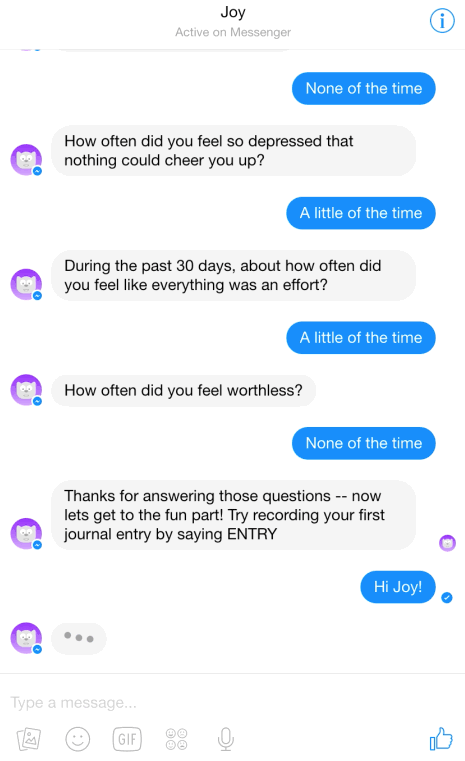Want smarter insights in your inbox? Sign up for our weekly newsletters to get only what matters to enterprise AI, data, and security leaders. Subscribe Now
Conventional wisdom says that automation, artificial intelligence, and chatbots may do away with many human-to-human interactions and reduce opportunities for emotional connection to mere transactions. However, there’s a new chatbot that endeavors to help people to open up, get in touch with their emotions, and, if needed, seek the help of mental health professionals.
The chatbot Joy made its debut on Facebook Messenger today. Using A.I. and natural language processors from IBM’s Watson and Microsoft’s LUIS, Joy tries to detect a user’s mood and keeps a journal about what it finds. This way a user can track their emotional state over time.
“My goal is not to replace therapists but rather to get more people who are in need to see a trained professional. Right now, it’s pretty simple, but in the future, it could connect you with a trained human therapist or even perform basic reminders and routine check-ins automatically,” said Danny Freed, who was inspired to create the bot after a friend committed suicide.
Freed says Joy is primarily targeted at people who don’t currently see a therapist or have much interaction with their own mental health.
AI Scaling Hits Its Limits
Power caps, rising token costs, and inference delays are reshaping enterprise AI. Join our exclusive salon to discover how top teams are:
- Turning energy into a strategic advantage
- Architecting efficient inference for real throughput gains
- Unlocking competitive ROI with sustainable AI systems
Secure your spot to stay ahead: https://bit.ly/4mwGngO
According to the National Institute of Mental Health, 43.6 million adults 18 or over suffered from a mental illness in 2014.
Freed admits that some people with serious mental health issues may treat Joy like a Band-Aid, but he thinks the bot’s impact will be positive. “There are millions of people who are struggling with their own mental health but are keeping it bottled up inside of their own head. Part of this is due to the stigma associated with mental illness. Amongst other things, Joy can provide an outlet to these people and encourage them to talk about their emotions,” he said.
Joy speaks to users daily about how they’re feeling. The bot does not make diagnoses, but can send weekly and monthly mood reports based on a user’s input which, according to Freed, “could potentially help identify mood disorders in the future.”

A health-related tool like Joy comes with a boatload of disclaimers. Joy does not replace a therapist, is not FDA approved, and should not be used in an emergency. It’s also not a suicide hotline (that number, in case you’re interested, is 1-800-273-8255) and has no trigger to suggest a user call 911 if they use words like suicide.
Joy is a side project for Freed, a product designer and front end developer, and was made with beta testers and a small advisory team. The biggest lesson he learned during its development was that technology is not the way to build the best therapy bot. A.I. and NLP are important and they’re a part of Joy, but that’s not how to make a human connection.
“Originally I was trying to force intelligence on people, rather than build a character with personality. Bots are an editorial problem, not a technological problem. Once I started focusing on this, the quality of conversations improved and in turn, [user] retention increased,” Freed said.
Joy is by no means the only way to track mental health on a smartphone.
The app Companion by Cogito is currently being tested at Brigham and Women’s Hospital study in Boston. It tracks a person’s mood by following the tone and intensity of their voice, the frequency they leave home, or frequency of messages or calls with friends.
There’s also the chatbot Eliza, and though it’s not intended for this purpose, the Microsoft-made bot Xiaoice has interacted with millions of Chinese speakers and is known to some who speak with it regularly as being a good listener.
In the future, Joy may evolve into a cognitive behavioral therapy tool to help treat things like anxiety, or to help companies track the general mood of employees, Freed said.


